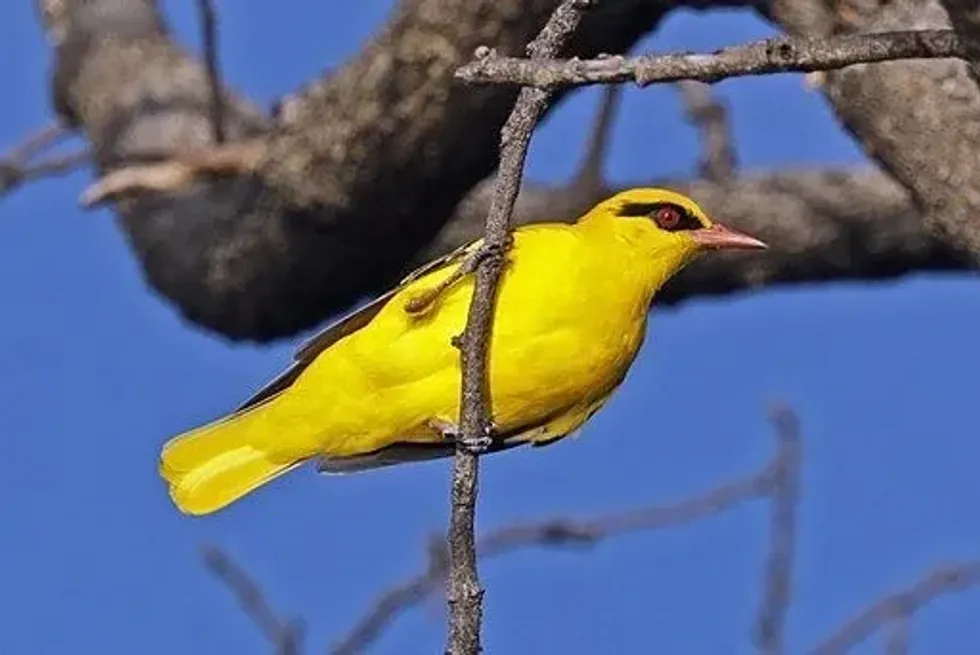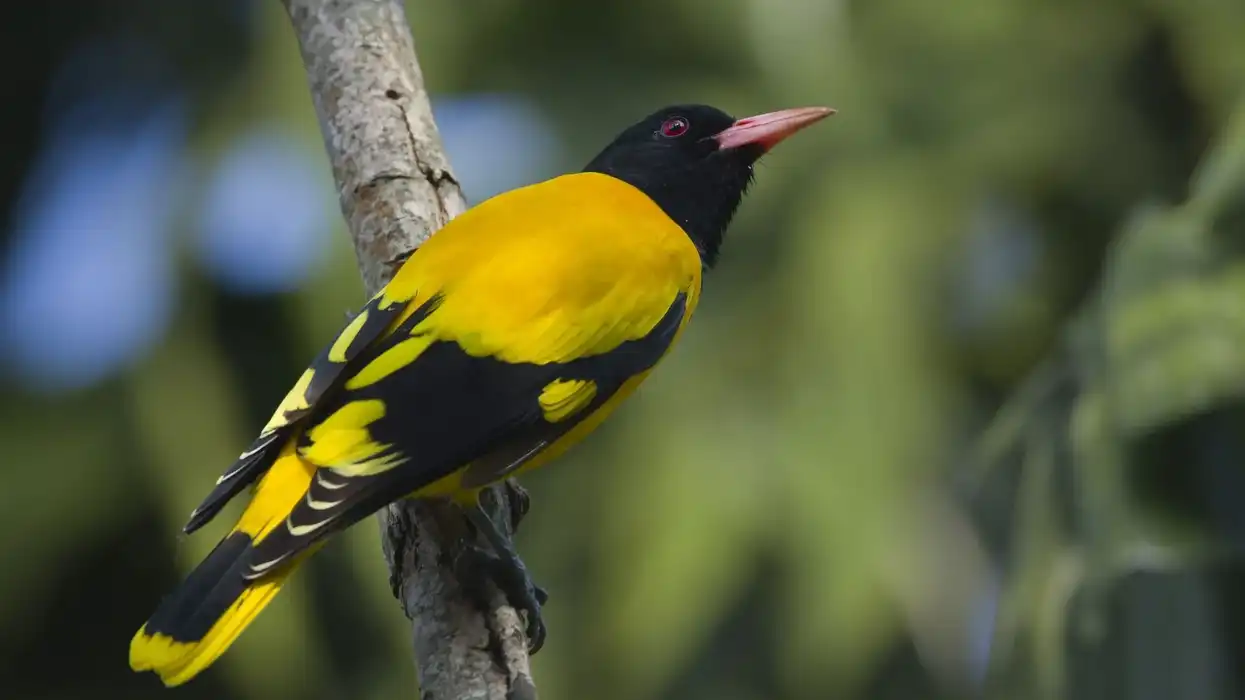The black oriole, Oriolus hosii, is a bird that belongs to the Oriolidae family of the order Passeriformes. This is the rarest among all the oriole species.
There are around 30 species in the genus Oriolus and family Oriolidae from the Old World, and 30 species in the genus Icterus and family Icteridae from the New World.
Some of the New World birds include the Baltimore oriole of northern America, the Bullock's oriole of western North America, and the orchard oriole of east America and Mexico.
The black oriole (Oriolus hossi) is only found in northwestern Borneo and has a very restricted range. They are birds of tropical montane and sub-montane forests and do not migrate to other regions.
In contrast to other members of the species, these are not the most colorful birds with their dark bodies and blue gloss in males and gray bellies in female birds. Their pointy red beaks and dark rust vent adds a tinge of color to their otherwise dull appearance.
The birds attract their mates by singing songs as a part of their mating rituals.
Both males and the females make their nests using different fibers where the females lay eggs in clutches of three to seven.
They have a short life span of about three and a half to four years in the wild and have varied food habits. They feed on various fruit items, foliages, and a variety of insects, including ants, spiders, caterpillars, and wasps to name a few.
Continue reading if you want to learn more such cool facts about these birds, and if you like this article, do check out hooded oriole and Bullock's oriole.
Black Oriole Interesting Facts
What type of animal is a black oriole?
The black oriole is a rare bird species of the Oriolidae family of the order Passeriformes.
What class of animal does a black oriole belong to?
The bird belongs to the class Aves of the Animalia kingdom.
How many black orioles are there in the world?
The black oriole (Oriolus hosii) is a very rare bird. The global range of this species is limited to Sarawak in Borneo, Malaysia where its population is declining due to activities such as habitat destruction. There is, however, not enough data available to ascertain the exact number of these birds currently living on the planet.
Where does a black oriole live?
The black oriole has a very restricted range. This lesser-known species is mostly seen in northwestern Borneo, in the Paya Maga highlands in Sarawak.
What is a black oriole's habitat?
The bird species are found in the tropical montane and sub-montane forests of Borneo.
Who do black orioles live with?
The black oriole is generally not seen in large groups. This bird species is mostly seen foraging alone quietly and sometimes in pairs or small groups.
How long does a black oriole live?
The bird species do not have a long lifespan and they live for approximately three and a half to four years in their natural habitat.
How do they reproduce?
There is not a lot of information on the black oriole's reproduction process. Breeding in these birds depends on the species. Most birds of this species attract mates by singing soft melodies.
They build their nests on trees using different plant fibers like grapevine bark and also use yarn and other man-made fibers. Females lay eggs in clutches of three to seven and incubate the eggs for about two weeks. The chicks hatch out of their eggs and roughly take another two weeks to start flying.
What is their conservation status?
According to the International Union for Conservation of Nature (IUCN) Red List, these birds have been enlisted as Near Threatened. Their current population is decreasing because of habitat loss in their lower habitat range.
Black Oriole Fun Facts
What do black orioles look like?
Oriolus hosii, is a rare species in contrast to the other species of Old World and New World families. The male Oriolus hossi has an ink-black plumage with black wings and a tad-bit blue gloss, while the female bird has a gray belly.
Both males and females of the species have bright red and pointy beaks with dark rust vents.
*Please note that this is an image of a golden oriole, not a black oriole. If you have an image of a black oriole, please let us know at hello@kidadl.com.
How cute are they?
The little bird can be considered cute by most people because of its small size.
How do they communicate?
Oriolus hosii attracts mates by bursting into soft melodies. Both sexes of the black oriole bird can sing and use short echoing songs to communicate with others.
How big is a black oriole?
There is not much information available on how big these birds are, but another member of the oriole species, the golden oriole (found in Central Asia and India), is 9.5 in (24 cm) in length. So, we can assume these birds are similar in size.
How fast can a black oriole fly?
This species of orioles fly swiftly and silently from hidden perches to catch flying insects or pick their prey from the ground.
How much does a black oriole weigh?
There is not much information about the weight of these rare species. However, the golden oriole, a bird of the same species, weighs about 1.97-2.78 oz (56-79 g) which is nearly the same weight as blue jays that weigh 2.4-3.9 oz (68-109 g).
What are the male and female names of the species?
Males and females of these species do not have any specific name. However, male birds are called cocks and female birds are called hens, just like any other bird species.
What would you call a baby black oriole?
A baby black oriole (Oriolus hossi) is called a chick.
What do they eat?
Not much information is available on what the black oriole eats. However, the New World species, belonging to different parts of North America, are mostly omnivores by nature. They eat plant leaves, as well as, insects. These birds hide on perches and observe their surroundings to spot insects.
Once they have spotted their prey, they catch these flying insects. They feed on caterpillars, beetles, worms, spiders, flies, and common wasps. They also enjoy different fruit items like berries.
Are they dangerous?
The Oriolus hossi is not dangerous since it has never been known to cause harm to humans.
Would they make a good pet?
No, they will not make a good pet. These species are stunning creatures, but they thrive well in their natural wild habitat.
Did you know...
Oriolus hossi gets its name from Charles Hose, the first person to collect the specimen of this species.
What kind of sound does an oriole make?
Orioles in general have a short echoing call and a whistling soft tune. These are shy birds, but their calls can be heard throughout their habitat.
What does a black oriole symbolize?
There is no information available on what the black oriole symbolizes, however, orioles, in general, are a symbol of peace and joy. They indicate better days and a brighter future.
Here at Kidadl, we have carefully created lots of interesting family-friendly animal facts for everyone to discover! For more relatable content, check out these orchard oriole facts and yellow oriole facts pages.
You can even occupy yourself at home by coloring in one of our free printable oriole bird coloring pages.










